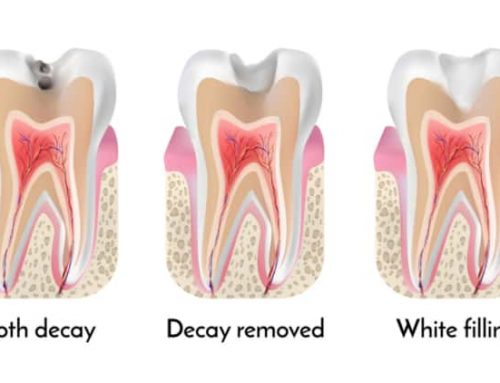Concerned about a badly decayed tooth? Modern dental treatments offer effective solutions to save even severely damaged teeth, restoring both function and appearance.
When a tooth is severely decayed, it’s easy to assume that extraction is the only option. However, at Pickett Family Dental in Keller, TX, we specialize in advanced dental treatments that can save badly decayed teeth. With the right approach, even teeth that seem beyond repair can often be restored to health, allowing you to keep your natural smile.
Learn About Tooth Decay The Damage It Causes
Tooth decay is caused by bacteria in the mouth that produce acids, which gradually erode the enamel and underlying dentin. If left untreated, decay can progress to the innermost part of the tooth, known as the pulp, leading to pain, infection, and even tooth loss. The sooner decay is addressed, the easier it is to treat. However, even when decay has reached an advanced stage, modern dental techniques can often save the tooth.
The most common symptoms of severe tooth decay include persistent toothache, sensitivity to hot or cold foods, visible holes or pits in the teeth, and discoloration. If you notice any of these signs, it’s important to seek dental care as soon as possible. Delaying treatment can lead to further damage, increasing the likelihood of needing more extensive—and expensive—procedures.

Root Canal Therapy: Saving the Tooth from the Inside
One of the most effective treatments for a badly decayed tooth is root canal therapy. This procedure is designed to save a tooth that is severely infected or decayed, preventing the need for extraction.
During a root canal, the dentist removes the infected or damaged pulp from the inside of the tooth. The pulp contains nerves and blood vessels, so when it becomes infected, it can cause significant pain. After the pulp is removed, the inside of the tooth is cleaned and disinfected, then filled with a biocompatible material. Finally, the tooth is sealed to prevent further infection.
Root canal therapy not only eliminates the infection but also preserves the structure of the tooth, allowing it to continue functioning normally. At Pickett Family Dental, we use the latest technology to ensure that root canal procedures are as comfortable and efficient as possible. In most cases, the treatment can be completed in just one or two visits.
Dental Crowns: Restoring Strength and Function
After a root canal, or in cases where a tooth is severely weakened by decay, a dental crown is often recommended to restore the tooth’s strength and function. A crown is a custom-made cap that covers the entire tooth, protecting it from further damage and restoring its appearance.
Crowns are made from durable materials such as porcelain, ceramic, or metal, and are designed to match the color and shape of your natural teeth. This means that not only will your tooth be strong enough to withstand normal chewing and biting, but it will also blend in seamlessly with the rest of your smile.
The process of getting a crown typically involves two appointments. During the first visit, the decayed portion of the tooth is removed, and the tooth is shaped to accommodate the crown. An impression is then taken to create a custom crown that fits perfectly over the prepared tooth. A temporary crown is placed while the permanent one is being made. At the second visit, the permanent crown is cemented in place, providing long-term protection and restoring the tooth’s appearance.
Dental Inlays and Onlays: An Alternative to Fillings
For teeth that are too damaged for a standard filling but not decayed enough to require a full crown, dental inlays and onlays offer an excellent solution. These restorations are custom-made to fit into the damaged area of the tooth, restoring its structure and preventing further decay.
Inlays and onlays are typically made from porcelain or composite resin and are bonded to the tooth for a strong, durable repair. An inlay fits within the cusps of the tooth, while an onlay extends over one or more cusps. This approach conserves more of the natural tooth structure compared to a full crown, making it a more conservative treatment option.
The procedure for inlays and onlays is similar to that for crowns. The decayed portion of the tooth is removed, and an impression is taken to create the custom restoration. Once the inlay or onlay is ready, it is bonded to the tooth, providing a precise and long-lasting repair.
The Importance of Early Intervention
While modern dental treatments can save badly decayed teeth, early intervention is always the best approach. The sooner decay is detected and treated, the less invasive and more successful the treatment is likely to be.
At Pickett Family Dental, we encourage regular dental check-ups as part of your oral health routine. During these visits, we can detect early signs of decay and provide prompt treatment to prevent the need for more extensive procedures. Regular check-ups also allow us to monitor the condition of any previous restorations, ensuring they remain effective and problem-free.
- Root canal therapy: Removes infection and preserves the tooth structure.
- Dental crowns: Strengthen and protect weakened teeth, restoring function and appearance.
- Inlays and onlays: Offer a conservative solution for moderate decay, preserving more of the natural tooth.
- Early intervention: Detects decay before it progresses, leading to simpler and more effective treatments.
Get the help you need to save your decayed teeth by scheduling an appointment at Pickett Family Dental in Keller, TX. Our experienced team is dedicated to providing the highest quality care to restore your smile and maintain your oral health.



